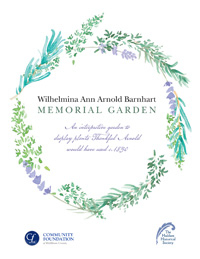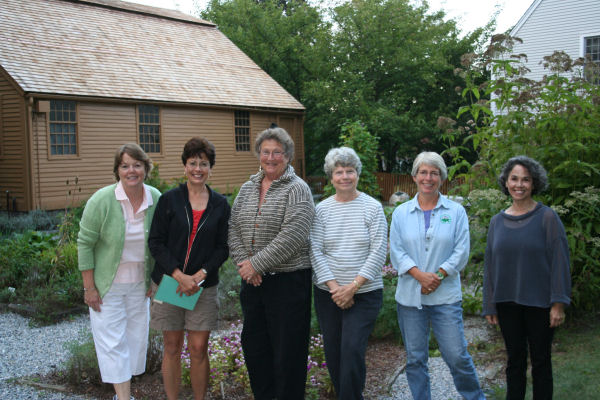The Wilhelmina Ann Arnold Barnhart Memorial Garden

The garden at the Arnold House is overseen by a handful of dedicated volunteers, who maintain it from early spring to late fall. The garden is open daily during daylight hours. A guided tour of the garden is available during museum hours and by appointment.
Named after a direct descendent of Joseph and Thankful Arnold, the original garden was designed and dedicated in 1973. The garden was given in memory of Wilhelmina Ann Arnold Barnhart by her father Isaac Arnold, the benefactor of the Thankful Arnold House. The original garden design was created by Sally Marvin of Bloomfield, Connecticut and featured an orchard, berry beds and bench garden.

The gardens were redesigned in the late 1980s in the Colonial Revival style with granite-edged beds and gravel paths. In 2000 the Connecticut Herb Study Group conducted extensive research to select plants commonly grown in household gardens in the lower Connecticut River Valley in about 1830. Most of the garden is now devoted to herbs used for cooking, medicine, dyeing, fragrance and other household uses, with a small bed featuring vegetables common in gardens in the early 1800s and a few old-fashioned annuals. More than 50 varieties of herbs are planted in the garden, including many of the ones Thankful Arnold would have used in about 1830. Although Thankful’s garden would have been larger and simpler in design, the garden is an informative, pleasant, relaxing place for visitors. The garden, which has been recognized by the National Home Gardening Club, was featured in the summer 2003 issue of People, Places and Plants magazine.

Now come out to the garden and I’ll show you some of the plants we grew and used. I didn’t have edged beds like you see here now, that style came after my time. I had a big garden with plenty of vegetables to feed our family with useful herbs planted among them. The gardens are planted now with herbs used in my time for cooking, medicine, dyeing, fragrance and household uses.
I grew a lot of root vegetables, like potatoes, turnips, onions and carrots, because they would keep through the winter in our cold cellar. By the end of that long winter you can believe we were ready for some green vegetables and that made this pot herb popular because it was one of the first to begin to grow. We called it All Good, I believe in your time it is called Good King Henry, but whoever heard of a ‘good king’. Sorrel is also an early green. We would usually cook them in soup and stews.
- An excerpt from the Widow Arnold’s tour of the garden

Connecticut’s Historic Gardens
In 2009 the Thankful Arnold House Museum was invited to join Connecticut’s Historic Gardens, a consortium of distinctive historic site and gardens throughout the Nutmeg State. Membership is by invitation only and just three sites were asked to join in 2009. The site joins other distinguished and nationally recognized gardens including the Florence Griswold Museum, Harkness Memorial State Park, and Hill-Stead Museum.
